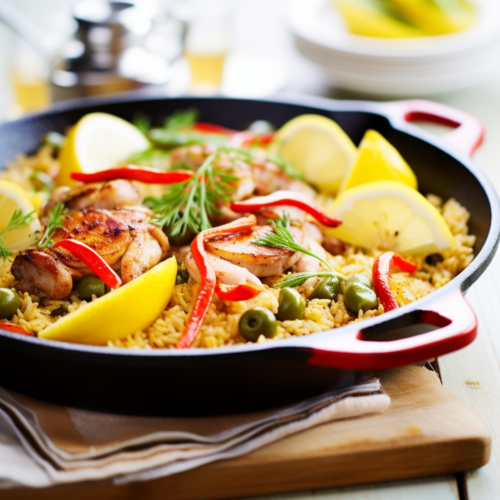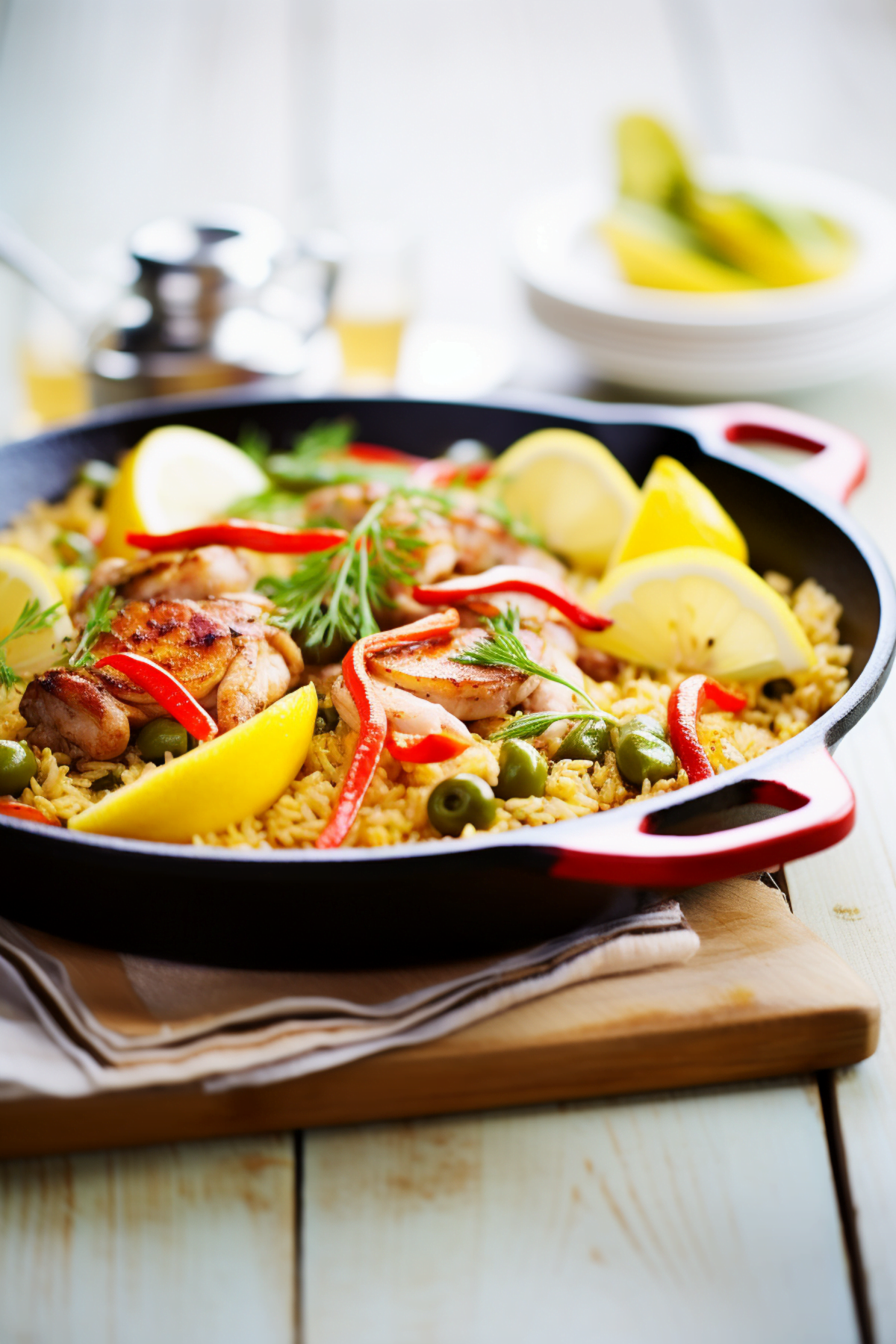Discover the Rich Flavors of Paella Valenciana with Chicken, Beans, and Artichokes
Embark on a culinary journey to the heart of Spain with a dish that encapsulates the vibrant spirit of Valencian cuisine. Paella Valenciana with Chicken, Beans, and Artichokes is not just a meal; it’s a celebration of rich flavors and wholesome ingredients. This traditional recipe promises to bring the essence of the Mediterranean to your table, offering a delectable experience that will delight your taste buds and nourish your body.
Whether you’re a seasoned chef or a home cook looking to expand your repertoire, this paella is a perfect choice. It’s a versatile dish that can be enjoyed on a cozy family dinner or as the centerpiece of a festive gathering. So, let’s dive into the world of Spanish gastronomy and explore the secrets to creating this iconic dish.

The Story Behind Paella Valenciana
The origins of Paella Valenciana trace back to the beautiful fields of Valencia, where farmers and laborers needed hearty meals to sustain them through long working days. This dish, steeped in history, has evolved over centuries but always remained true to its roots, using locally sourced, fresh ingredients to create a harmonious blend of flavors and textures.
Traditional Paella Valenciana is known for its generous use of rabbit, chicken, and sometimes snails, combined with green beans, white beans, and artichokes when in season. The key to its distinctive taste lies in the use of saffron and smoked paprika, which give the dish its signature color and aroma. Moreover, the unique, slightly chewy texture of the Bomba or Calasparra rice absorbs the flavors beautifully, making every bite a testament to the region’s culinary prowess.
In this rendition, we focus on chicken as the primary protein, complemented by robust beans and tender artichokes, which are more accessible yet still honor the dish’s Valencian identity. The inclusion of these ingredients not only adds depth to the flavor profile but also enhances the nutritional value, offering a balanced meal that is both satisfying and healthful.

Mastering the Method
The secret to a perfect Paella Valenciana lies in the method. Start by heating olive oil in a traditional paella pan, which allows for even heat distribution and helps to develop the coveted ‘socarrat’—the crispy crust that forms at the bottom of the pan. Brown the chicken thoroughly to lock in the juices and set aside, allowing the flavors to meld.
Next, sauté the onions and bell peppers until soft, adding garlic at the right moment to prevent it from burning. Incorporating the tomato sauce and allowing it to simmer with the aromatics is crucial, as it forms the base of the flavor profile. When adding the rice, make sure to stir it well to coat each grain with the mixture, which is essential for achieving the dish’s signature texture.
As you pour in the chicken broth, remember to distribute it evenly and resist the temptation to stir once the rice is added. This practice is vital for the development of the socarrat. Add the chicken back, followed by the green beans and artichokes, and cook covered on a low simmer. It’s important to monitor the heat and liquid absorption, as the rice should be tender but not mushy. After resting, garnish with fresh parsley and serve with lemon wedges to enhance the flavors.

Variation: Seafood Paella Valenciana
For a coastal twist, replace chicken with a mix of seafood such as shrimp, mussels, and clams. The seafood infuses the rice with a briny depth, reminiscent of the Mediterranean Sea. Be sure to add the seafood towards the end of cooking to avoid overcooking.
Variation: Vegetarian Paella Valenciana
Vegetarians can enjoy this dish by substituting the chicken with a variety of seasonal vegetables like zucchini, bell peppers, and peas. Use vegetable broth instead of chicken broth to maintain the rich flavor profile while keeping it plant-based.
Variation: Mixed Paella Valenciana
A mixed paella incorporates both meat and seafood, offering a symphony of flavors. Combine chicken, rabbit, and a selection of seafood for a truly indulgent dish that celebrates the diversity of Mediterranean ingredients.
Substitutions for Paella Valenciana
While traditional ingredients are preferred, sometimes substitutions are necessary. If Bomba or Calasparra rice is unavailable, Arborio rice can be used as an alternative. It’s important to note that Arborio rice may require slightly more liquid and a careful eye to prevent sticking.
If saffron is out of reach, turmeric can be used to achieve the golden hue, although it won’t replicate saffron’s distinct flavor. Additionally, for those who cannot consume chicken, rabbit is a traditional alternative that offers a leaner protein option with a subtle, gamey flavor.
For the beans, if traditional Valencian varieties are not available, any green bean variety can be used. The key is to maintain the texture and color contrast in the dish.
FAQs About Paella Valenciana
What is the best pan to use for Paella Valenciana?
The ideal pan is a wide, shallow, and flat-bottomed paella pan, which allows the rice to cook evenly and develop the socarrat.
Can I make Paella Valenciana on a stovetop?
Yes, although traditionally cooked over an open flame, a stovetop will suffice. Just ensure the pan fits the burner well to distribute the heat evenly.
How do I achieve the perfect socarrat?
Cook the paella on a low simmer and avoid stirring once the rice is added. Listen for a crackling sound and check the bottom of the pan for a caramelized crust.
Can I use long-grain rice instead of short-grain?
It’s not recommended, as long-grain rice doesn’t absorb the flavors as well and may become too soft. Stick to short-grain varieties like Bomba or Calasparra.
Is Paella Valenciana gluten-free?
Yes, when using the traditional ingredients listed, Paella Valenciana is naturally gluten-free.

Paella Valenciana with Chicken, Beans, and Artichokes
Equipment
- Paella pan or wide shallow skillet
- Chopping board
- Knife
- Measuring cups and spoons
- Wooden spoon
Ingredients
- 1 pound chicken thighs, boneless and skinless, cut into pieces
- 1 cup short-grain paella rice
- 3 cups chicken broth
- 1 large onion, diced
- 1 red bell pepper, sliced
- 4 cloves garlic, minced
- 8 ounces green beans, trimmed and cut into 2-inch pieces
- 8 ounces canned artichoke hearts, drained and quartered
- 1/2 cup tomato sauce
- 1 teaspoon smoked paprika
- 1/2 teaspoon saffron threads
- Salt and pepper to taste
- 3 tablespoons olive oil
- Lemon wedges for serving
- Fresh parsley, chopped for garnish
Instructions
- Heat olive oil in a large paella pan or wide shallow skillet over medium-high heat. Add chicken pieces and brown on all sides. Season with salt and pepper. Remove chicken and set aside.
- In the same pan, add the onion and bell pepper. Cook until the onion is translucent, about 5 minutes. Add garlic and sauté for another minute until fragrant.
- Stir in tomato sauce and cook for 2 minutes. Add the rice, smoked paprika, and saffron threads, stirring to coat the rice in the mixture and cook for another 2 minutes.
- Pour in the chicken broth and bring to a simmer. Add the chicken back to the pan, distributing it evenly.
- Reduce heat to medium-low, cover, and cook for 15 minutes without stirring.
- Add the green beans and artichoke hearts, distributing them evenly throughout the pan. Cover and cook for an additional 15 minutes, or until the rice is tender and the liquid has been absorbed.
- Remove from heat and let stand for 5 minutes, covered. Garnish with fresh parsley and serve with lemon wedges.
Notes

